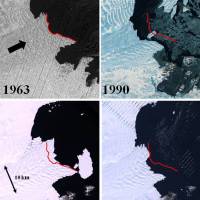Part of East Antarctica is more vulnerable than expected to a thaw that could trigger an unstoppable slide of ice into the ocean and raise world sea levels for thousands of years, a study Sunday showed.
The Wilkes Basin in East Antarctica, stretching more than 1,000 km (600 miles) inland, has enough ice to raise sea levels by 3 to 4 meters (10-13 feet) if it were to melt as an effect of global warming, the report said.
The Wilkes is vulnerable because it is held in place by a small rim of ice, resting on bedrock below sea level by the coast of the frozen continent. That "ice plug" might melt away in coming centuries if ocean waters warm up.
"East Antarctica's Wilkes Basin is like a bottle on a slant. Once uncorked, it empties out," Matthias Mengel of the Potsdam Institute for Climate Impact Research, lead author of the study in the journal Nature Climate Change, said in a statement.
Co-author Anders Levermann, also at Potsdam in Germany, said the main finding was that if set in motion, the ice flow would be irreversible. He said there is still time to limit warming to levels to keep the ice plug in place.
Almost 200 governments have promised to work out a U.N. deal by the end of 2015 to curb increasing emissions of man-made greenhouse gases that a U.N. panel says will cause more droughts, heat waves, downpours and rising sea levels.
Worries about rising seas that could swamp low-lying areas from Shanghai to Florida focus most on ice in Greenland and West Antarctica, as well as far smaller amounts of ice in mountain ranges from the Himalayas to the Andes.
Sunday's study is among the first to gauge risks in East Antarctica, the biggest wedge of the continent and usually considered stable. "I would not be surprised if this (basin) is more vulnerable than West Antarctica," Levermann said.
Antarctica, the size of the United States and Mexico combined, holds enough ice to raise sea levels by some 57 meters (188 feet) if it ever all melted.
The study indicated that it could take 200 years or more to melt the ice plug if ocean temperatures rise. Once removed, it could take between 5,000 and 10,000 years for ice in the Wilkes Basin to empty as gravity pulls the ice seaward.
"It sounds plausible," Tony Payne, a professor of glaciology at Bristol University who was not involved in the study, said of the findings. The region is not an immediate threat, he said, but "could contribute meters to sea level rise over thousands of years."
The United Nations panel on climate change says it is at least 95 percent probable that human activities such as burning fossil fuels — rather than natural swings in the climate — are the dominant cause of warming since the 1950s.
Sea levels are likely to rise by between 26 and 82 cm (0.85 to 2.7 feet) by the late 21st century, after a rise of 19 cm (0.6 feet) since 1900, it says. Antarctica remains the biggest uncertainty.


















With your current subscription plan you can comment on stories. However, before writing your first comment, please create a display name in the Profile section of your subscriber account page.